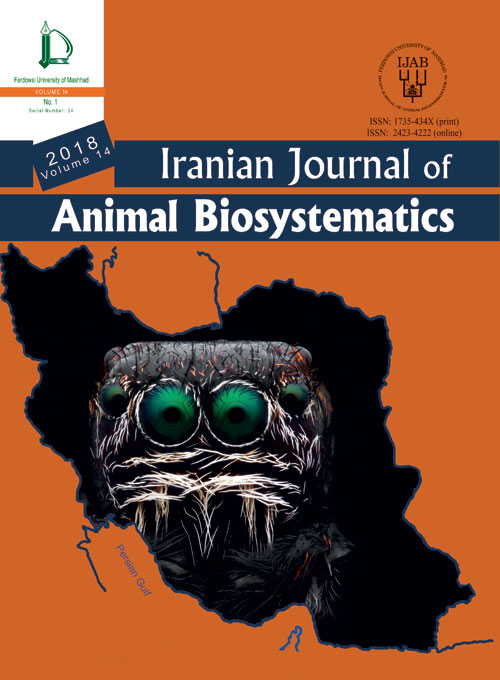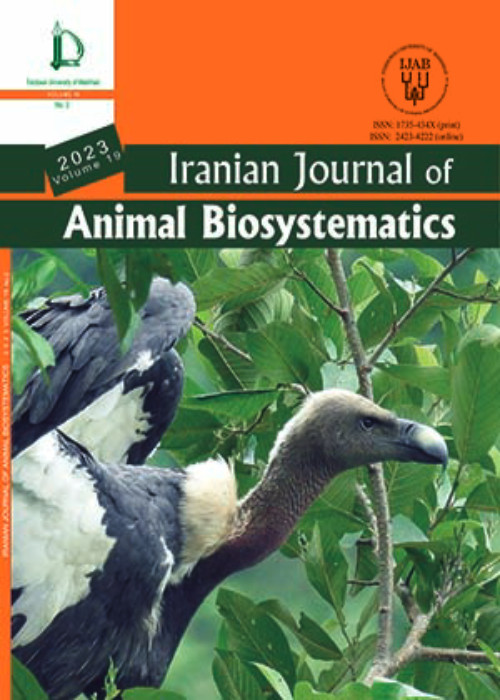فهرست مطالب

Iranian journal of animal biosystematics
Volume:14 Issue: 1, Winter-Spring 2018
- تاریخ انتشار: 1397/01/18
- تعداد عناوین: 9
-
-
Pages 1-6This paper is a new report of a Holothuroidea (Apodida: Synaptidae: Protankyra) Protankyra psudodigitata from Persian Gulf. Specimen was collected by a Van Veen Grab from subtidal soft bottoms in May 2016. The specimen recorded was small measuring 12 mm in length, body worm-like in shape with microscopic ossicles orientated in the body wall. The size and shape of ossicles are Characteristic of species and found similar to previous reports of P. psudodigitata. The present study describes the taxonomic diagnoses of identified species bases on morphological characters.Keywords: Holothuroidea, Protankyra pseudodigitata, ossicles, Persian Gulf
-
Pages 7-14Tardigrada is a phylum closely allied with the arthropods. They are small (0.05-1.20 mm), hygrophilous micrometazoans, have four pairs of lobe-like legs and are either carnivorous or feed on plant material. Most of the tardigrade species are limno-terrestrial. In two moss and lichen samples collected in Mashhad, one heterotardigrade species was found. Echiniscus testudo (Doyère, 1840) belongs to the Echiniscidae group and differs from most of other species in this group mainly by having a different claw configuration and by some morphometric characters. This study is the first report of tardigrades from Iran.Keywords: Water bears, Middle East, Tardigrada, Biogeography, Diversity
-
Pages 15-27The genetic variation of narrow-clawed crayfish (Astacus leptodactylus, Eschscholtz, 1823) from Caspian Sea including two sites (Astara and Kiashahr), Aras region, Anzali lagoon and three rivers (Chafrood, Masuleh, and Siah Darvishan) was evaluated and their genetic variation on the basis of DNA microsatellite loci was estimated. DNA from pleopods of 194 specimens extracted and was examined with six microsatellite markers. Genetic differences between the populations were discerned by pairwise comparison based on allelic distribution. The average numbers of alleles per locus ranged from 2 to 10, while the average observed heterozygosity (Ho) at various loci varied between 0.222 to 0.732, implying that a midway level of genetic variation. Among seven populations Siah Darvishan population displayed the highest level of variability in terms of heterozygosity. Tests of Hardy-Weinberg showed that the microsatellite loci deviated significantly in most populations indicating deficit of heterozygote. The results indicate that some of the above populations are significantly differentiated from one another based on pairwise FST estimates. Genetic distance based measures supported the clustering of Siah Darvishan, Chafrood and Astara may be genetically discrete from other narrow-clawed crayfish populations. The neighbor-joining dendrogram topology and multidimensional scaling approach (MDS) constructed on the basis of genetic distances among populations supported observed division between the populations. The non-significant differentiation between crayfish samples from the Anzali lagoon, Kiashahr and Masuleh can be explained by a relatively recent disconnection of these three populations and/or small amounts of gene flow. These results could give applicable information for cultivation of stocks and also for future genetic improvement of this commercial species by selective breeding program.Keywords: Astacus leptodactylus, Microsatellite DNA, Stock structure, Caspian Sea
-
Pages 29-35In this study a total of four Calotes versicolor specimens (three males, one female), collected in different localities from April 2013 to March 2014 in Southeast of Iran were examined. The study was based on morphological features including color pattern, morphometric measurements, habits, biological observations especially habitat and distribution. Habits features, habitat and new distribution localities were documented. This is the first record of Calotes versicolor from the Kalesari village is 44 km away from the last record in Nahang River.Keywords: Agamidae, Calotes versicolor, Distribution, Habits, Habitats, Iran
-
Pages 37-42To evaluate the lizard fauna of the Sistan region, field work was conducted from 2014 to 2015 in five sampling locations as Zabol, Zahak, Hirmand, Nimrooz and Hamoon towns. Field work was done during both day and night at all sites. In total, 196 specimens were collected and identified using available identification keys. Collected lizards belong to six families: Agamidae, Lacertidae, Gekkonidae, Sphaerodactylidae, Scincidae and Varanidae. A total of 10 genera and 15 species of lizards were represented. Gekkonidae was the most diverse family with four genera and four species.Keywords: Sistan lizard’s fauna, Eastern Iran, Helmand basin, reptiles
-
Pages 43-54We present a review of earlier records of distribution of the Mehely's horseshoe bat, Rhinolophus mehelyi, in Iran together with new distribution records of this bat obtain during recent years (2014–2017). Until 2012, R. mehelyi had been recorded from 14 localities in Iran. Records of new localities, updated distribution maps and new echolocation-call information are important contributions of this rarely species. This contribution, reports ten new locality records for R. mehelyi in Iran that increases the species known range mainly over Zagros Mts. Here, we also report echolocation-call parameters for 42 individuals caught in six caves which represent the first record of this species in Iran.Keywords: Chiroptera, Iran, new records, Rhinolophus mehelyi, Zagros Mountains
-
Pages 55-64As a recently described species, Mediodactylus ilamensis is one of the least studied species of endemic reptiles of Iran. In this study a total number of 11 specimens of Mediodactylus ilamensis were collected from type locality (Zarin-Abad) as well as a new locality in Dinar-Kooh Preserved area, Abdanan Township approximately 27 km on an aerial line in the east of type locality. To investigate morphological variation and reveal sexual dimorphism we employed 32 metric and meristic characters. The most important morphological characteristics of this species are as follow: all scales of the body, with the exception of intermaxillaries, nasals, chin shields, and upper and lower labials, strongly keeled; postmentals absent, dorsal crossbars broad and equal to, or wider than, interspaces; scales of frontal and supraocular regions toward snout are multi-keeled (in some scales up to six keels) and polyhedral. Of the studied morphological characters only two are different significantly between males and females: number of active precloacal pores and ear diameter (vertical). Based on the new material, the validity of M. ilamensis as a full species, well distinguishable from other species of Mediodactylus, is confirmed. Observations on taxonomy, ecology and behavior are given.Keywords: Carinatogecko, Iran, Ilam, Dinarkooh
-
Pages 65-68As there was no record of Miniphila miniago (Freyer, 1840) (Lepidoptera, Noctuinae) from Iran in any recent taxonomic catalogs and due to description of its closest species Miniphila persago (Gyulai & Ronkay, 2006) from Iran, the occurrence of M. miniago in Iran which was reported 40 years ago was doubtful. In this study, specimens identified and reported as M. miniago preserved at the Hyke Mirzayans Insect Museum and types of M. persago were evaluated and compared. Result revealed that the old record of M. miniago (Freyer, 1840) from Iran is incorrect and it is indeed M. persago. Diagnostic characters for separating these two closely allied species and data on their distribution are presented.Keywords: Miniphila miniago


